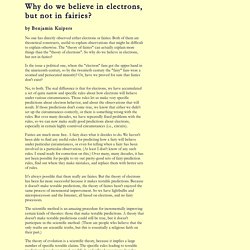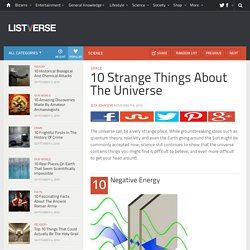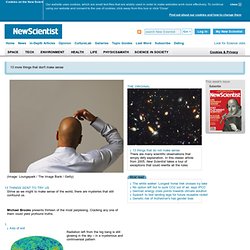

Why do we believe in electrons, but not in fairies? By Benjamin Kuipers No one has directly observed either electrons or fairies.

Both of them are theoretical constructs, useful to explain observations that might be difficult to explain otherwise. The "theory of fairies" can actually explain more things than the "theory of electrons". So why do we believe in electrons, but not in fairies? Is the issue a political one, where the "electron" fans got the upper hand in the nineteenth century, so by the twentieth century the "fairy" fans were a scorned and persecuted minority? 10 easy arithmetic tricks. Welcome to Future City. 6 Things You Won't Believe Science Can Do With DNA. DNA gets a bad rap.

It's the most sophisticated substance in existence, and thanks to CSI we think of it as murderer semen. Or we watch it proving that talk show guests who everybody (including them) hopes never reproduce have done exactly that. 10 Strange Things About The Universe. Space The universe can be a very strange place.

While groundbreaking ideas such as quantum theory, relativity and even the Earth going around the Sun might be commonly accepted now, science still continues to show that the universe contains things you might find it difficult to believe, and even more difficult to get your head around. Theoretically, the lowest temperature that can be achieved is absolute zero, exactly ? 273.15°C, where the motion of all particles stops completely. However, you can never actually cool something to this temperature because, in quantum mechanics, every particle has a minimum energy, called “zero-point energy,” which you cannot get below. One of the properties of a negative-energy vacuum is that light actually travels faster in it than it does in a normal vacuum, something that may one day allow people to travel faster than the speed of light in a kind of negative-energy vacuum bubble.
Freaky Fractal Fingers, Fingers, Fingers. In his 1941 novel Methuselah's Children, science fiction author Robert Heinlein writes about a human baby modified by an alien race.

A chemical that can turn your organs transparent. Science’s 10 hottest fields. Understanding the genome The sequencing of the 6 billion chemical “letters” of human DNA was completed in draft in 2000 and in final form in 2003.

But clinical benefits have arrived more slowly than the initial hype suggested. This is mainly because the human genome actually works in a much more complex way than predicted by the late-20th-century model. Twenty-first-century research shows that we have only 21,000 genes, one-fifth of the number predicted when the project started, and that just 1.5 per cent of the genome consists of conventional protein-coding genes. Efforts are under way to understand the vital regulatory and other functions of the non-coding regions of the genome, once dismissed wrongly as “junk DNA”.
Top 10 Scientific Discoveries of 2010. Now that 2010 has come to a close, we take a look at the top ten scientific discoveries and breakthroughs of this past year. 10.

Scientists find life built with Arsenic An astrobiology research has found the first known organism able to thrive and reproduce using the toxic chemical arsenic, which has changed the fundamental knowledge about what comprises all known life on Earth. Phosphorus is a central component of the energy-carrying molecule in all cells and also the phospholipids that form all cell membranes. Arsenic, which is chemically similar to phosphorus, is poisonous for most life on Earth.
This discovery of a life form with a different biochemistry makeup will alter biology textbooks and expand the scope of the search for life beyond Earth. Biggest Scientific Breakthroughs of 2011 - StumbleUpon. TOP TEN UNSOLVED PROBLEMS IN PHYSICS.
Pyschology Tests & Surveys. Göbekli Tepe: Older Than Stonehenge, Pyramids, Anything. 6 Insane Discoveries That Science Can't Explain. We like to feel superior to the people who lived centuries ago, what with their shitty mud huts and curing colds by drilling a hole in their skulls.

But we have to give them credit: They left behind some artifacts that have left the smartest of modern scientists scratching their heads. For instance, you have the following enigmas that we believe were created for no other purpose than to fuck with future generations. 13 more things that don't make sense.
Cookies on the New Scientist website close Our website uses cookies, which are small text files that are widely used in order to make websites work more effectively.

To continue using our website and consent to the use of cookies, click away from this box or click 'Close' What is your body language saying? Narrowing the red margins of your lips is a clear sign of anger, while massaging your forehead can signal uneasiness. Brushing hair off your face is a combination of nerves and flirtationIf you nod in clusters of three, the speaker will sense your interestStuffing your hands in your pockets means you're probably hiding somethingIn a seated conversation, lifting your toes means your feelings are extra-positive (RealSimple.com) -- Every last gesture -- whether it's a tilt of the head or plain fidgeting -- tells a story. Do you look down when you speak? Play with your hair? Lean to one side? Learn what you're telling others with your body language -- and what others are telling you with theirs. 7 Man-Made Substances that Laugh in the Face of Physics.
13 more things that don't make sense. What would happen if I drilled a tunnel through the center of th" Want to really get away from it all?

The farthest you can travel from home (and still remain on Earth) is about 7,900 miles (12,700 kilometers) straight down, but you'll have to journey the long way round to get there: 12,450 miles (20,036 kilometers) over land and sea.